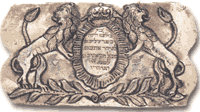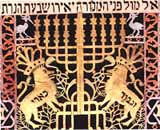| From
ancient times to the present, the "Lion of Judah" has been one
of the most popular symbols of the Jewish people. The Bible mentions the
lions that roamed the deserts and mountains of the regions more than 150
times by six different names. Both the tribes of Dan
and Judah are compared to lions, although it is Judah whose name ultimately
became inextricably linked with this symbol (David, a descendant of Judah,
is identified with the lion, as is the Davidic monarchy and the Messiah
who will spring from this royal house). The writings of the Sages often
draw moralistic analogies between the lion and the righteous individuals.
For these and other reasons, the lion is heavily represented in Jewish ceremonial
art. |
|

Belt buckles for Yom Kippur
Eastern Europe, 19th century
|
The lion motif was common
in the ancient Middle Eastern civilizations as a battling, fighting and attacking
force. In the Bible, the lion is portrayed as both capable of destroying and
punishing, and of saving and protecting. In ancient Jewish art we find the lions
in this protective role, guarding the Holy Ark or at the entrances to the chapel,
as in the sculpture of the ancient synagogues at Sardis (in Asia Minor), Horazin
and Bar'am (in Palestine), and in many mosaics dating from the early Byzantine
period.
In medieval times, the lion
appears frequently in Jewish ceremonial art —
on the Holy Ark, Torah crowns, papercuts, menorot and other decorative
objects. Standing, reclining or leaping, they are almost always in harmonious
pairs, by contrast with other animals that are depicted in a state of struggle.
It is possible, speculate art historians, that these lions, particularly those
on many Torah Ark doors and curtains, are symbolic replacements of the original
cherubim that once adorned the Ark of the Tabernacle in the Mishkan (portable
Temple in the wilderness) and the Temple in Jerusalem.[1]
|

Papercut (detail)
Hebrew text: "Brave as a lion"
Eastern Europe, 19th century
|
Other scholars speak of
the influence of the medieval European heraldic lions decorating either side
of the crests of the nobility, symbolizing balance, justice, order or guardianship.
In medieval Jewish art, we find the lion pair commonly leaning up on either
side of the Tree of Life, next to the crown; thus is the heraldic shield replaced
by a symbol of God, and the lions are seen as serving the King of all Kings.
During the last two centuries, lions on Jewish ceremonial art are generally
portrayed carrying the Tablets, a continuation of the same idea. This formal
arrangement, writes art historian Ida Huberman, "uses the lions as a multifaceted
representation of the material reality underlying Creation, of the Jewish people
adhering to the Torah, and of the spirit and workings of the Creator. The lions
are the link between the earthly elements and the infinite, celestial and metaphysical."[2]
THE
LION IN THE ZODIAC
Click
to view enlarged

The
confrontation of the lion and the unicorn, symbolic perhaps of the
link between earthly and celestial forces, appears on the ceiling
of the Hodorov synagogue.
Beth Hatefutsoth Permanent Exhibit
|
|
The twelve-fold division
of the zodiac, an imaginary zone in the heavens first developed by Chaldean
astronomers, spread to the West about the beginning of the Christian Era. The
twelve divisions are mostly commonly represented by animals. There is no mention
of the zodiac in the Talmud; It is first mentioned in the Sefer Yezirah,[3]
where the names given to the 12 signs are direct translations of the
Latin names.[4]
These zodiacal signs figured prominently in early Jewish art, for example on
the mosaic floors of ancient Palestinian synagogues (e.g., Bet Alfa, Hammat
Tiberias ) as well as in medieval siddurim (prayerbooks), ketubbot
(marriage contracts) and Torah binders.
A passage in the Midrash
Pesikta Rabbati, a medieval Midrash on the festivals of the year, explains
the names of the signs homiletically in accordance with Jewish history.[5]
For example: Taurus is connected with the calf which Abraham slaughtered
for his angelic guests; Gemini represent Jacob and Esau; and the Temple was
destroyed in the month of Av, since Leo, its zodiacal sign —
or Aryeh (lion in Heb.), corresponds to Ariel ("Lion of God"),
one of the names for Jerusalem and the Temple.[6]
|
[1]
In the Ark of the Tabernacle, two wooden cherubim overlaid with gold faced
one above the Ark in the Tabernacle, form the throne of God with their
outstretched wings (Ex. 25:18-20; 37:7-9). They are the counterparts of
the two huge found in the Holy of Holies (devir) of Solomon's Temple.
[back]
[2]
Ida Huberman, Living Symbols: Symbols in Jewish Art and Tradition,
p...? [back]
[3]
Book of Creation, the earliest extant Hebrew text of systematic, speculative
thought, known to have been in existence as early as the tenth century.
[back]
[4]Thus
Aries is called Taleh; Taurus, Shor; Gemini, Te'omim;
Cancer, Sartan; Leo, Aryeh; Virgo, Betulah; Libra,
Moznayim; Scorpio, Akrav; Sagittarius, Keshet; Capricorn,
Gedi; Aquarius, Deli (bucket), and Pisces, Dagim.
[back]
[5]Pesikta
Rabbati, Freedman edition, 1880, 27-28:133b. [back]
[6]
Isaiah 29:1 [back]
|
|
Ida
Huberman, Living Symbols: Symbols in Jewish Art and Tradition.
Iris Fishoff, Written in the Stars — Art
and Symbols of the Zodiac (Jerusalem: The Israel Museum, 2001).
 Ellen
Frankel & Betsy Platkin Teutsch, The Encyclopedia of Jewish Symbols
(New Jersey: Jason Aronson Inc., 1992). Ellen
Frankel & Betsy Platkin Teutsch, The Encyclopedia of Jewish Symbols
(New Jersey: Jason Aronson Inc., 1992).
Encyclopedia
Judaica. |
 |
Lions
in the JHOM Judaica Art Gallery |
LIONS
Table of Contents
|